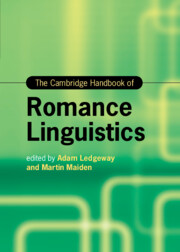Book contents
- The Cambridge Handbook of Romance Linguistics
- Cambridge Handbooks in Language and Linguistics
- The Cambridge Handbook of Romance Linguistics
- Copyright page
- Dedication
- Contents
- Figures
- Tables
- Contributors
- Abbreviations
- 1 Data, Theory, and Explanation: The View from Romance
- Part One What Is a Language?
- Part Two Phonetics and Phonology
- 5 Structure of the Syllable
- 6 Sandhi Phenomena
- 7 Effects of Stress
- 8 The Notion of the Phoneme
- 9 Typologically Exceptional Phenomena in Romance Phonology
- Part Three Morphology
- Part Four Syntax
- Part Five Semantics and Pragmatics
- Part Six Language, Society, and the Individual
- Index
- References
8 - The Notion of the Phoneme
from Part Two - Phonetics and Phonology
Published online by Cambridge University Press: 23 June 2022
- The Cambridge Handbook of Romance Linguistics
- Cambridge Handbooks in Language and Linguistics
- The Cambridge Handbook of Romance Linguistics
- Copyright page
- Dedication
- Contents
- Figures
- Tables
- Contributors
- Abbreviations
- 1 Data, Theory, and Explanation: The View from Romance
- Part One What Is a Language?
- Part Two Phonetics and Phonology
- 5 Structure of the Syllable
- 6 Sandhi Phenomena
- 7 Effects of Stress
- 8 The Notion of the Phoneme
- 9 Typologically Exceptional Phenomena in Romance Phonology
- Part Three Morphology
- Part Four Syntax
- Part Five Semantics and Pragmatics
- Part Six Language, Society, and the Individual
- Index
- References
Summary
Since its beginnings, phonological research has sought to discover constants below the phonetic flow associated with the linguistic expressions produced by speakers. Saussurean distinctiveness as the core property of phonemic units in European structuralism on a par with the functional criteria at the base of American phonemics have led to an interpretation of phonological phenomena in terms of distributional constraints on the phonetic segments, placing them in relation to some abstract level. We argue for the inadequacy of this approach in order to interpret the relation between lexical properties and the mapping onto the sensory-motor level. Specifically, the main formal requirements such as linearity, invariance, and biuniqueness of structural phonemics are called into question by the fact that harmonies, metaphonies, and other phonetic mechanisms provided by Romance systems escape such procedures and require a more powerful theory involving a cognitive level of organization. In fact, the speaker is able to master very complex phonological knowledge, including processes neutralizing underlying differences and types of overlapping, for which the notion of phoneme is of no use. On the contrary, these processes support an analysis in which lexical representations are connected to surface occurrences by rules and derivations as a part of the language capacity.
Keywords
- Type
- Chapter
- Information
- The Cambridge Handbook of Romance Linguistics , pp. 261 - 291Publisher: Cambridge University PressPrint publication year: 2022

